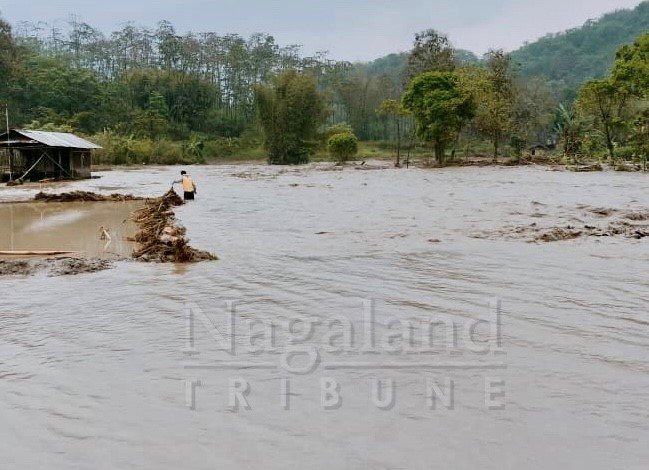The Directorate of Economics & Statistics, Government of Nagaland has released the 1st Report on Nagaland Disaster Statistics 2023 that provides a better understanding into how the impact of climate change in Nagaland is getting severe every year. The report highlights disaster incidents in the State from 2018 to 2021 that are accident related, biological related, geological related and water and climate related.
“Natural and anthropogenic cause damages to the environment due to adverse geologic and climatic conditions, rapid population growth, increased concentration of population in hazardous environments and lack of adequate infrastructure has resulted in escalation and severity of natural disasters in the State,” the report states. The frequency and intensity of most of the hydro meteorological hazards are compounded by the climate change and its impacts on agriculture, horticulture, human settlement and human and animal health, NDS 2023 says.
The report shows that Water & Climate Related incidents increased by over 200% between 2018 to 2021. In 2018, the total incidents reported was 337 which rose slightly in 2019 to 414 and then almost doubled in 2021 to 814.

However, Biological related incidences (epidemics, pest infestations, etc) and Geological related incidences (landslides and earthquakes, etc) which are mostly triggered by climate change witnessed slight respite in 2020-21 from 2019-20.
Meanwhile, Accident related incidences (fires, road accidents, electrocution, etc) saw a rise from 99 in 2018-19 to 195 in 2020-21.
As per the Nagaland Disaster Statistics 2023, in 2018-19, a total of 1840 hectares of AGRICULTURAL CROPS such as paddy, maize, millet, oil seeds, and pulses suffered significant damage crops due flash flood and soil erosion. In 2019-20 the affected crops reduced to 1210.16 hectares which were caused by multitude of calamities, including flash floods, strong winds, soil erosion, drought, hailstorms, excessive rainfall, and even scanty rainfall. However, in 2021-2022, the damage to agricultural crops grew alarmingly to 104052.95 hectares mostly due to drought.
“These statistics shed light on the urgent need for resilient farming practices, improved irrigation systems, and sustainable water management to mitigate the effects of climatic fluctuations and safeguard food security for vulnerable communities”, the report states.

Moreover, storms and HAILSTORM caused destruction to 680 acres of HORTICULTURAL CROPS in the period of 2019-20 while in the subsequent year, 2020-21, the loss increased to 1169.41 acres. The devastating toll continued to escalate during 2021-22, with a staggering 5451 acres of horticultural crop areas decimated by various types of disasters. This widespread destruction encompassed a diverse range of crops, including Avocado, Banana, Lemon, Potatoes, Kiwi, Naga Mircha, Large Cardamon, King Chili, Apple, Citrus, Passion Fruit, Ginger, Pineapple and other vegetables, the Nagaland Disaster Statistics 2023 states.

The Directorate of Economics & Statistics highlights that the total number of DROUGHTS was 21 during 2018-19, which rose to 43 in 2019-20, and further escalated to 63 during 2020-21. It also pointed out that the districts of Mon and Longleng experienced the highest number of drought incidents, while Wokha, Kohima, and Mokokchung reported either nil or negligible occurrences. This highlights the growing frequency of droughts in certain regions and emphasizes the need for proactive measures to address the impact of such natural disasters, the report says.
The NDS 2023 also emphasises the urgent need for effective FLOOD management and preparedness measures particularly in low-lying areas such as Dimapur, Peren, and Mon districts. A total of 659 flood incidents were reported during the last three years. Floods not only damage crops, livestock, transportation, communication, and soil fertility but also lead to serious epidemics like malaria and cholera.

Furthermore, the Nagaland Disaster Statistics 2023 says that there is an escalating trend of COLD WAVE incidents in the state over the last three years. In 2018-19, there were 7 cases, which doubled to 14 in 2019-20, and further increased to 31 in 2020-21, surprisingly no cold wave reports were recorded in the districts of Kiphire, Kohima, Phek, and Wokha. The districts that reported cold wave incidences were Longleng, Dimapur, and Tuensang.
The trend is the same for HAILSTORMS that rose from 26 cases in 2018-19 to 32 in 2019-20 and then 55 in 2020-21. The district of Mokokchung reported the highest number of incidents caused by hailstorm.

The Nagaland Disaster Statistics 2023 Report also points to the concerning trend of increasing CLOUDBURST incidents over the years where in 2018-19, there were 7 cases, which rose to 12 in 2019-20, and significantly escalated to 49 in 2020-21. The district of Mon reported the highest number of cloudburst incidents, accounting for 39 cases in three years.

It mentions that a total 481 cases of disaster caused by CYCLONES were registered over the last three years, the department stressed on the need for comprehensive disaster preparedness and mitigation strategies to address the cyclone-related risks in the State. The report points out that while cyclone impacts have been widespread, affecting all districts of the state, Zunheboto and Longleng districts reported the highest number of incidents caused by cyclones, while Kohima and Peren districts experienced fewer incidents.


